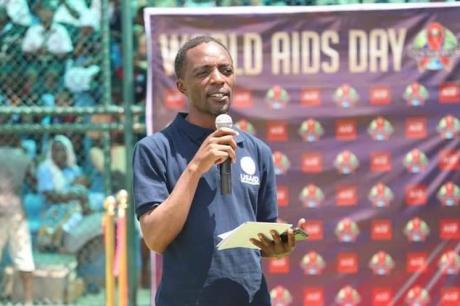
Community HIV testing and educational event hosted by the Public Health Authority of Hertford County, North Carolina, featuring their mobile medical unit
Published March 10, 2015, last updated on June 3, 2020 under Research News
In a 2009 Lancet article co-authored by Duke Global Health Institute (DGHI) director Michael Merson, global health was described as “the area of study, research and practice that places a priority on improving health and achieving equity in health for all people worldwide.” However, often when people think of global health, they envision this work being done primarily in low- and middle-income countries.
At DGHI, while most of our work is focused internationally, we believe that global is local and local is global. In fact, it’s one of our core values. And dozens of faculty, scholars, and students at DGHI are translating this principle into action through a wide range of projects in North Carolina and the United States. In many of these projects, DGHI partners with health organizations and U.S.-based universities.
What Does “Global Is Local and Local Is Global” Really Mean?
DGHI’s mission is to reduce health disparities worldwide, including in our local communities. Many rural, urban and suburban areas within the United States have populations for whom access to health care is a constant struggle.
Beth Stringfield, a researcher at DGHI’s Center for Health Policy and Inequalities Research (CHPIR), noted that some Americans living in rural areas face some of the same challenges that exist in low-and middle-income countries. For example, in an HIV/AIDS study in rural eastern North Carolina—which she’s conducting with CHPIR’s associate director Kimberly Walker and global health professor Sara LeGrand—participants must travel long distances to receive medical care and deal with intense stigma attached to their disease. And in another project, more than 90% of the participants were living below the poverty line, limiting their ability to pay for the care they need.
Another interpretation of “global is local and local is global” is the perspective that our global health work reflects an exchange of ideas between cultures and communities: we learn from researchers and community members in other countries, and they learn from us. Part of this approach involves understanding the communities and people with whom we work—whether in the U.S. or other countries—and incorporating local knowledge and culture into our research and practice within that community.
As an extension of this sharing of expertise, in many cases we can apply our experiences in an international context to settings within the United States. For example, Kate Whetten, professor of global health and public policy and director of CHPIR, was part of a team that recently completed a study of orphanages in five countries; she is currently looking at opportunities to conduct a similar study in the United States.
“We need to learn what’s common about human behaviors and processes and what’s culturally and environmentally derived,” Whetten reflected. “We can use this knowledge in communities around the world, including here in Durham, to provide a different lens into how we view situations and come up with more creative solutions to health care challenges.”
Addressing Health Disparities in the U.S.’s Deep South
DGHI’s U.S.-based projects span a range of health care issues, including access to care, substance abuse, obesity prevention, cancer, and more, mirroring the work DGHI researchers are doing outside of the U.S. Much of the “global is local” work at DGHI is being done by researchers at CHPIR, where a number of projects focus on HIV/AIDS in the southern U.S. Patients in poor communities in this area, which has been hit disproportionately hard by HIV/AIDS, encounter numerous barriers to accessible, affordable, high-quality care for their disease.
In a recent study led by CHPIR research associate Susan Reif, for example, the research team found that the U.S. Deep South had the nation's lowest five-year survival rate among those diagnosed with HIV or AIDS in 2003-2004. Fifteen percent of people diagnosed with HIV and 27 percent of those diagnosed with AIDS during that time died within five years of diagnosis.
Reif said that poverty, lower levels of education and insurance coverage, social stigma associated with the disease and racism are among the factors that contribute to these poor outcomes. The study demonstrates that it’s critical to consider differences in characteristics and outcomes of individuals with HIV in the Deep South states when creating strategies to address HIV in the region.
CHPIR research scholar Kristen Sullivan also conducts local HIV/AIDS research. She recently co-authored an article resulting from the Guide to Healing project, which seeks to enhance the entry, retention and re-entry of HIV-positive women of color into care in the University of North Carolina Infectious Diseases Clinic. In the study, a licensed registered nurse with mental health training (“nurse guide”) provided systems navigation, education, and autonomy support services to women of color with HIV, enabling them to remain in HIV care.
The findings suggest that a properly trained nurse guide can provide critical medical and psychosocial support that helps eliminate barriers to engagement in HIV care and facilitate patient HIV self-management.
These are just a few examples of DGHI’s domestic projects. To learn more about our “global is local and local is global” work, visit our website and the CHPIR website.


